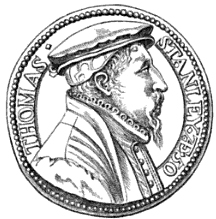William Humfrey facts for kids
William Humfrey (also spelled Humphrey or Humphreys) lived from about 1515 to 1579. He was a skilled English goldsmith, which means he worked with gold and other precious metals. He also helped start new mining projects and was the Assay Master at the Royal Mint during the time of Queen Elizabeth I. The Royal Mint is where coins are made, and an Assay Master is someone who tests metals to make sure they are pure enough for coins.
Contents
Life and Work
We don't know much about William Humfrey's early life before 1560. Around that time, he was a member of the Worshipful Company of Goldsmiths in London. This was a special group for people who worked with gold.
Humfrey became friends with Sir William Cecil, who later became a very important advisor to Queen Elizabeth I. Sir William Cecil thought Humfrey was an expert on metals and helped him a lot with money and support.
Working at the Royal Mint
In 1561, Humfrey became the Assay Master at the Royal Mint. At this time, England was trying to make its money better because the old coins weren't very pure. German experts came to England to help with this. Humfrey and Sir William Cecil learned from these experts that German methods could help England's mining industry.
Humfrey was especially interested in a mineral called calamine. This mineral was important for making latten and brass, which are types of metal. In 1563, he brought a German metal expert named Christopher Schutz to England.
New Mining Ideas
In 1564, Schutz and twenty German workers built England's first blast furnace in a place called Tintern. A blast furnace is a huge oven used to melt metals.
Humfrey and Schutz worked together and got special permission from the Queen to look for calamine in England and Ireland. They also got permission to mine and process the ore. Soon after, in 1566, they found calamine in the Mendip Hills. They developed a new way to use this calamine to make brass. In 1568, the first real brass made in England using this new method was shown to everyone.
Challenges at the Mint
While Humfrey was busy with mining, he faced a difficult situation at the Mint. In 1565, another official at the Mint, Thomas Stanley, made accusations against Humfrey. It seemed that Humfrey and a colleague had tried to cause trouble for Stanley. Humfrey was held for a short time, but because Sir William Cecil supported him, he was able to get his job back as Assay Master in 1567.
Starting New Companies
In 1568, Queen Elizabeth I created two new companies: the Society of Mines Royal and the Company of Mineral and Battery Works. These were early examples of joint-stock companies, where many people put money together to fund a big project. Humfrey was a shareholder in the first company and a main shareholder in the second.
The Company of Mineral and Battery Works took over Humfrey and Schutz's projects. They focused on making brass, metal wire, and other metal products. However, getting calamine from the Mendip Hills was very expensive. So, the company changed its plans and used the furnace at Tintern to make iron wire for wool-carding, which was a new idea for England. But this project also had financial difficulties.
Lead Mining and New Inventions
Around 1569, Humfrey started working with lead. He and Schutz developed two important things for the English lead industry around 1570:
- They built a water-powered lead-smelting furnace near Sheffield. This furnace used water to help melt the lead.
- They used a special German sieve to process lead ore in Derbyshire.
Humfrey's water-powered furnace was much better than the old ways of melting lead. It quickly became very popular. However, many people started using his new methods without his permission or paying him. Humfrey tried to stop them, but it was difficult.
Because of these problems in Derbyshire, Humfrey decided to try something new. He started a silver-mining project in Wales.
Humfrey's Legacy
William Humfrey's water-powered lead-smelting furnace was very important. It helped the mining industry grow a lot after 1570, and England started exporting a lot of lead. Sadly, Humfrey didn't live to see how successful his ideas became. In 1578, he wrote to Lord Burghley, saying he was struggling financially. He passed away in July 1579.
Family Life
William Humfrey was married to a woman named Alice. They had two daughters:
- Elizabeth Humfrey, who married Robert Ledger, a merchant taylor, in 1570.
- Alice Humfrey, who married an embroiderer named Alexander Fownde.


